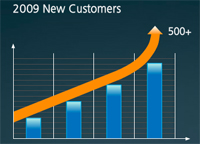 One theme of this blog is that IC EDA is increasingly inspecting its own navel while the bulk of design is going on in the PCB and FPGA worlds (not to mention software). One company that is focused on this market is Altium. They used to be called Protel and were famous for a couple of things. Firstly, they were Australian. And secondly they sold their software at a very low price, partially because it wasn’t really state-of-the-art when compared with the more expensive packages. Today they are around $50M in revenue, with about 300 people world-wide, so that intermediate size where they are no longer small but still not the market share leader (in dollars). Worldwide they have about 40,000 individual licenses.
One theme of this blog is that IC EDA is increasingly inspecting its own navel while the bulk of design is going on in the PCB and FPGA worlds (not to mention software). One company that is focused on this market is Altium. They used to be called Protel and were famous for a couple of things. Firstly, they were Australian. And secondly they sold their software at a very low price, partially because it wasn’t really state-of-the-art when compared with the more expensive packages. Today they are around $50M in revenue, with about 300 people world-wide, so that intermediate size where they are no longer small but still not the market share leader (in dollars). Worldwide they have about 40,000 individual licenses.
Over the last few years they revamped their product into a single integrated platform which was first released in 2004. I talked with Jeff Hardison and Bob Potock last week about their business strategy and their results.
The money quote is that last year over 500 US companies (companies, not individual engineers) switched to Altium Designer last calendar year. And they are strict about what counts as a switch: the company was not a customer with the older product, they were using a competitor’s tools (Mentor, Cadence or Zuken, who I thought was no longer around). In a few cases they counted separate divisions of large companies as separate companies but it is not material to the 500 number.
This is obviously a very nice result to have. Anyone in EDA would love to have 500 new customers switch from a competitor to their product. So they decided to survey them to find out why.
Since Altium Designer sells for $4,595 including the entire platform incorporating tools for PCB design, FPGA design, embedded software, IP delivery, verification, change-control and more, price would be one likely reason. A few people identified price but, by and large, people switched because Altium Designer is better in some dimension: easy to switch, easy to use, unified platform. Once these people had switched then a whopping 84% reckoned that their productivity had improved by at least a factor of 2, and nearly a quarter of them reckoned it had improved by a factor of 4 or more. One thing that seems to help a lot in ramping up on the new tool is the 3-400 “how-to” videos that Altium has available.
By any measure these are impressive results. If a “company” averages (I’m guessing) 5-10 engineers then 500 companies is 2,500 to 5,000 new individual users (out of 40,000). And remember, this is in the US alone. Most EDA companies are struggling to maintain their revenues an to open new accounts in the current downturn, making these numbers more remarkable.
Their competition is basically Mentor and Cadence with tool-chains that have been put together over the years by acquisitions. By contrast, Altium bit the bullet and built a completely new fully integrated architecture where everything is held consistent. For example, if you re-assign a pin on an FPGA you’d like that to automatically update things inside the FPGA (so that when the FPGA is routed it uses the new pin assignment) and outside on the board (so that the PCB traces correctly go to the right pins). In Altium this indeed happens. In other tool chains, not so much. You can even buy add-on tools to take care of this deficiency.
It reminds me of the tools we built from the ground up at VLSI which had many of the same attributes although with less automation (computers and databases were much more primitive 20 years ago). I’ve argued before that for most people, a Ferrari is better than a Formula-1 racecar; a fully integrated turnkey solution that just works and is an order of magnitude cheaper. Altium are delivering on this but with one big difference: the Ferrari goes faster than the F-1 racecar.
One thing that I immediately thought of is that if Altium sells their software for $5,000 and if almost everyone is listing better rather than cheaper as the reason they switched then aren’t they leaving money on the table? It reminds me of Model Technology in the early days when it sold a VHDL simulator for about the third of the cost that Cadence and Synopsys were selling Verilog simulators. They had the best VHDL simulator out there and I’m convinced they’d have sold almost as many at twice the price.
Well, I’m not going to do any more of Altium’s marketing for them but it is nice to see a company focusing on the 95% of designs that are not SoCs and disrupting an established market both from below, Innovator’s Dilemma style with a lower price point, and from above, delivering a premium product.
